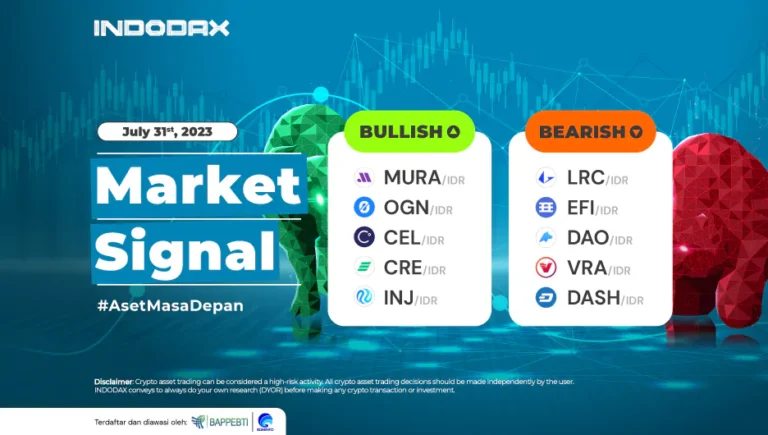During recent global economic progress, stagflation is an important thing to watch. This condition can affect various assets, including crypto assets.
Therefore, it is important to understand the concept of stagflation and its implications for investing in managing investment risk effectively.
To find out more about stagflation, see the full review below.
What Is Stagflation?

Stagflation is a term used to describe a situation when there is an agreement between economic stagnation or low economic growth and high inflation.
Meanwhile, economic stagnation is when a country’s economic growth slows down or stops for a significant period.
The term stagflation combines the words “stagnation,” which means the inability to grow or develop, and “inflation,” which refers to a general and continuous increase in the price level of goods and services.
In a stagflation situation, economic growth slows down or stops while prices for goods and services continue to rise.
This creates a difficult combination because normally, under normal conditions, low or stagnant economic growth will affect the inflation rate so that prices will tend to stabilize or even fall.
However, in the case of stagflation, it is not uncommon for a combination of slowing or stagnant economic growth to occur with high inflation.
Factors Causing Stagflation
Previously, the factors that caused stagflation would help to understand and overcome these difficult economic conditions.
In addition, understanding the causes of stagflation is important for taking preventive measures, formulating appropriate policies, identifying relevant economic indicators, and understanding the social and political consequences that may occur.
Thus, knowledge of the causes of stagflation can help to deal with this complex economic challenge more effectively.
The following are several factors that cause stagflation that needs to be known, including:
1. Decrease in global demand
Global demand drops when major countries or key markets face economic downturns or recessions.
This also resulted in a significant decrease in demand for goods and services.
The impact could be far-reaching for the global economy, including for countries that depend on exports for economic growth.
A decline in global demand can lead to stagflation for several reasons, including declining exports, falling commodity prices, decreasing foreign direct investment (FDI), and currency depreciation.
2. Financial crisis
A financial crisis occurs when a country’s financial system is seriously disrupted, which can hurt the economy as a whole.
Meanwhile, financial crises can cause stagflation due to decreased investment and consumption, hard-to-find credit, decreased income and employment, high inflation, and currency volatility.
3. Structural changes in the economy
Structural change occurs when significant changes occur in the structure and composition of a country’s economy.
Several things related to structural changes in the economy can lead to stagflation, including changes in the industrial sector, structural response, technology and automation, slowing population growth, and changes in economic policies.
4. Inappropriate monetary and fiscal policies
Economic stagnation and high inflation can occur when the economic policies implemented by the government and the central bank are not by actual economic conditions.
Several things related to improper monetary policy and fiscal policy can lead to stagflation.
For example, monetary policy needs to be more accommodative, and fiscal policy needs to be balanced—lack of coordination of monetary and fiscal policies, policy policies, and protectionist policies.
Impact of Stagflation

Understanding the impact of stagflation is very important because it can provide insight into how this complex economic condition affects various aspects of economic and social life.
Understanding the impact of stagflation helps governments, financial institutions, and economic actors identify solutions and implement appropriate policies to overcome this problem.
A balanced economic policy is needed to respond to stagflation, including appropriate fiscal and monetary policies, restructuring the economic sector, and measures to control inflation and promote sustainable economic growth.
The following are some of the impacts of stagflation that need to be known, including:
1. The decline in people’s purchasing power
One of the significant impacts of stagflation is the decline in people’s purchasing power.
Stagflation is marked by a combination of economic stagnation and high inflation, which directly impacts the purchasing power of individuals and households.
Stagflation can cause a decrease in people’s purchasing power due to several factors, including rising prices of goods and services, decreased real income, reduced employment, economic uncertainty, and reduced social welfare.
2. Declining investment from within and outside the country
Another impact of stagflation, namely the decline in investment both from within the country and abroad.
Stagflation creates economic conditions that are unstable and unattractive to investors, thereby impeding investment flows.
Factors causing investment to decline due to stagflation include:
- Economic uncertainty.
- Lack of growth prospects.
- Risk of high inflation.
- Financial pressure on companies.
- Policy uncertainty.
3. Decreased production and employment
A significant impact of stagflation is a decline in production and employment in the economy.
Economic stagnation and high inflation could have severe consequences for production and employment.
Some impacts may include decreased production, layoffs, lack of investment and innovation, decreased consumer purchasing power, and social instability.
4. Increasing government debt
One of the possible effects of stagflation is the increase in government debt.
Stagflation created difficult economic conditions with reduced economic growth and high inflation.
Several factors can lead to increased government debt in a stagflationary situation:
- Decreased income
- Decreased tax compliance
- The need for economic stimulus
- Higher interest costs
- Poor financial market conditions
Methods and Steps You Can Take to Overcome Stagflation
An understanding of ways and steps that can be taken to overcome stagflation is important in dealing with this condition.
On the other hand, it is also important to note that each country has a different economic context and challenges, so the steps to be taken may vary.
Success in overcoming stagflation requires a coordinated and sustainable approach between the central bank, the government, the private sector, and other stakeholders.
Here are some ways and steps that can be done, including:
1. Streamlining the bureaucracy
Streamlining the bureaucracy is one of the steps that can be taken to overcome stagflation.
Several ways and steps can be taken to streamline the bureaucracy, including evaluating policies and regulations, trimming the bureaucracy, simplifying business procedures, digitalization and e-government, increasing accountability and transparency, and training and developing human resources.
Streamlining the bureaucracy is a long-term effort that requires government commitment, cooperation between agencies, and active participation from the private sector and society.
By streamlining the bureaucracy, administrative processes will become more efficient, spending costs will be reduced, and investment and economic growth can be encouraged.
2. Providing incentives to the industry to increase production
Providing incentives to industry to increase production is one of the steps that can be taken to overcome stagflation.
Several ways and steps can be taken to incentivize the industry, namely cutting taxes, fiscal stimulus, facilities, infrastructure, funding, and credit, increasing collaboration, and improving workforce skills.
3. Control government spending
Controlling government spending is one of the steps that can be taken to overcome stagflation.
Several ways and steps that can be taken to control government spending are austerity policies, subsidy reform, reducing budget deficits, increasing bureaucratic efficiency, monitoring and supervising the budget, and prioritizing expenditures.
4. Stabilize currency exchange rates
Stabilizing currency exchange rates is also one of the steps that can be taken to overcome stagflation.
Several ways and steps that can be taken to achieve exchange rate stability include tight monetary policy, currency intervention, disciplined fiscal policy, increased exports and economic diversification, macroeconomic stabilization, and international cooperation.
5. Encouraging economic growth and reducing inflation
Encouraging economic growth and reducing inflation are interrelated objectives in overcoming stagflation.
Several ways and steps can be taken to achieve these two goals:
- Accommodative monetary policy
- Stimulating fiscal policy
- Structural reforms
- Investment in research and innovation
- Increasing awareness of Labor performance
- Anti-inflation policies
The Effect of Stagflation on Asset Markets
Stagflation can affect asset markets, including crypto assets.
Therefore, understanding the effect of stagflation on the asset market is very important because stagflation can have a significant impact on the value and performance of various types of crypto assets.
In conditions of high inflation, crypto assets such as Bitcoin and Ethereum can be an option for some investors to protect against inflation.
Some of the reasons why crypto assets can be considered as protection against inflation are as follows:
1. Limited supply
Bitcoin and Ethereum have a limited supply. Bitcoin, for example, is capped at a maximum of 21 million coins, whereas Ethereum has plans to shift to a “burning” model that could reduce supply.
This limited supply means that these crypto-assets can expand slowly, unlike traditional currencies, which governments can print more of.
In conditions of high inflation, when fiat currencies can depreciate, crypto assets with limited supply can provide some protection against a decline in value.
2. Decentralization
Crypto assets such as Bitcoin and Ethereum are designed to operate decentralized without interference from governments or financial institutions.
These characteristics give investors confidence that the value of crypto assets will not be affected by monetary policies or government decisions that might trigger inflation.
That way, investors see crypto assets as a safer alternative to protecting the value of their wealth.
3. Global demand
Bitcoin and Ethereum are digital assets that can be accessed globally.
The demand for these crypto assets is not limited to one particular country or region, so inflation factors in a country do not directly affect the value of crypto assets.
Meanwhile, solid global demand can maintain stability or increase the value of crypto assets in inflationary conditions.
However, in conditions of economic stagnation, investors tend to seek more stable and secure assets such as government bonds or gold.
Government bonds are considered relatively stable because they have low credit risk.
When there is economic stagnation, government bonds are often considered safer because the government can finance its debt obligations through tax power and print money.
Government bonds also have a fixed term and guaranteed rate of return, which can provide stability for investors in the face of economic uncertainty.
Meanwhile, gold has long been considered a haven asset during economic uncertainty.
The value of gold tends to persist or even increase during economic stagnation because gold has intrinsic properties as a precious metal that is rare and resistant to inflation.
Gold is also considered a hedge against currency fluctuations and financial market volatility.
Therefore, investors often allocate a portion of their portfolio to gold to reduce risk during periods of economic stagnation.
Conclusion
In conclusion, stagflation can be caused by several factors, including declining global demand, the financial crisis, structural changes in the economy, and inappropriate monetary and fiscal policies.
Stagflation will also affect the asset market, including crypto assets, with several impacts, including high price volatility, the decline in the value of crypto assets, and negative market sentiment.
However, the crypto asset market also has unique characteristics and dynamics because when there are high inflation conditions, some investors may see crypto assets as protection against inflation.
Countries experiencing stagflation can take steps to overcome this condition and promote economic growth.
Several steps can be taken in this regard, including appropriate fiscal policy, monetary policy, structural reforms, and political stability.
In times of economic stagnation or high uncertainty, investors will generally look for more stable and secure assets.
They want to protect the value of their wealth from high fluctuations and risks associated with an unstable market.
Some of the types of assets that investors generally look for in this situation include government bonds, gold, high-quality corporate bonds, stock dividends, and real estate.
So, now you understand what stagflation is, its causes, and ways to overcome it.
Furthermore, you can read other interesting articles, such as hyperinflation, and understand what GDP is at INDODAX Academy.
Come on, learn about the world of digital assets right now!








